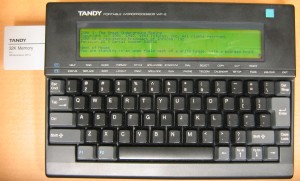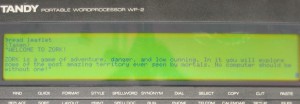As part of my project to run Zork on the Tandy WP-2, I found it useful to dump the ROM and take a peek at what it was doing. While the Service Manual (available online from Club 100, the Internet Archive, and other places) contains a wealth of information, the code is the definitive place to look for information on how something works.
In order to dump the contents of the ROM, I wrote the below to read each code page, and write it out the serial port. I compiled it with z80asm from Udo Munk’s z80pack. I loaded the resulting binary onto the WP-2 by using a drive emulator (dlplus on Linux) and captured the results from the serial port to a file. I then used an old version of IDA which supported the Z80 to perform the disassembly.
Combining the entry points from the service manual with the disassembly I could follow the code to answer questions regarding the operation of the WP-2 that were not completely clear from the manual.
; dumps all of the ROM banks to the serial port ; sets the serial port to 9600 ; compile with z80asm -fb -vl DUMPROM.CO CHARSENSE equ 100H CHARGET equ 103H SETLOC equ 109H GETLOC equ 10CH CURSORON equ 10FH CURSORTYPE equ 112H CHAROUT equ 118h PUTCHAR equ 1A3H STROUT equ 11BH CLS equ 11EH BEEP equ 121H RSINIT equ 140H GETDATALEN equ 143H SENDDATA equ 146H GETDATA equ 149H RSCLOSE equ 14CH CHGSLOT equ 166H LINEIN equ 1A6H BKSP equ 008H LF equ 00AH CR equ 00DH ESC equ 01BH ORG 0AC00H-8 DEFB 'PR' DEFW PRGEND-PRGTOP+1 DEFW START DEFW 0000H PRGTOP START CALL CLS NOP NOP NOP NOP NOP NOP NOP NOP NOP NOP NOP NOP NOP NOP NOP NOP NOP NOP NOP NOP NOP NOP NOP NOP NOP NOP NOP NOP NOP NOP NOP NOP NOP NOP NOP NOP NOP NOP NOP NOP NOP NOP NOP NOP NOP XOR A ld (CURSLOT),a CALL CHGSLOT ; change to slot zero to start ld hl,0h ; start at zero to read the first bank ld (current),hl call DUMPLOOP MAINLOOP: call BEEP ; We dumped another block ld hl,4000h ; remaining banks start at 4000h ld (current),hl ld a,(curslot) inc a ld (curslot),a ; bump to next slot cp 0Fh ; if slot 15 (IC Card) jr z,DONE ; then we are done call CHGSLOT call DUMPLOOP ; otherwise dump it jr MAINLOOP DONE: xor a CALL CHGSLOT ; change back to slot zero xor a ret DUMPLOOP: ld hl,084Dh ; 9600 bps, 8n1, no xon, timer enabled call RSINIT BYTELOOP: ld hl,(current) ld a,(hl) inc hl ld (current),hl call SENDDATA ld a,h cp 080h jr nz,BYTELOOP call SENDDATA ; for some reason we have to send ; another dummy byte before the close call RSCLOSE ret CURRENT DEFW 00000H CURSLOT DEFB 0h PRGEND END

